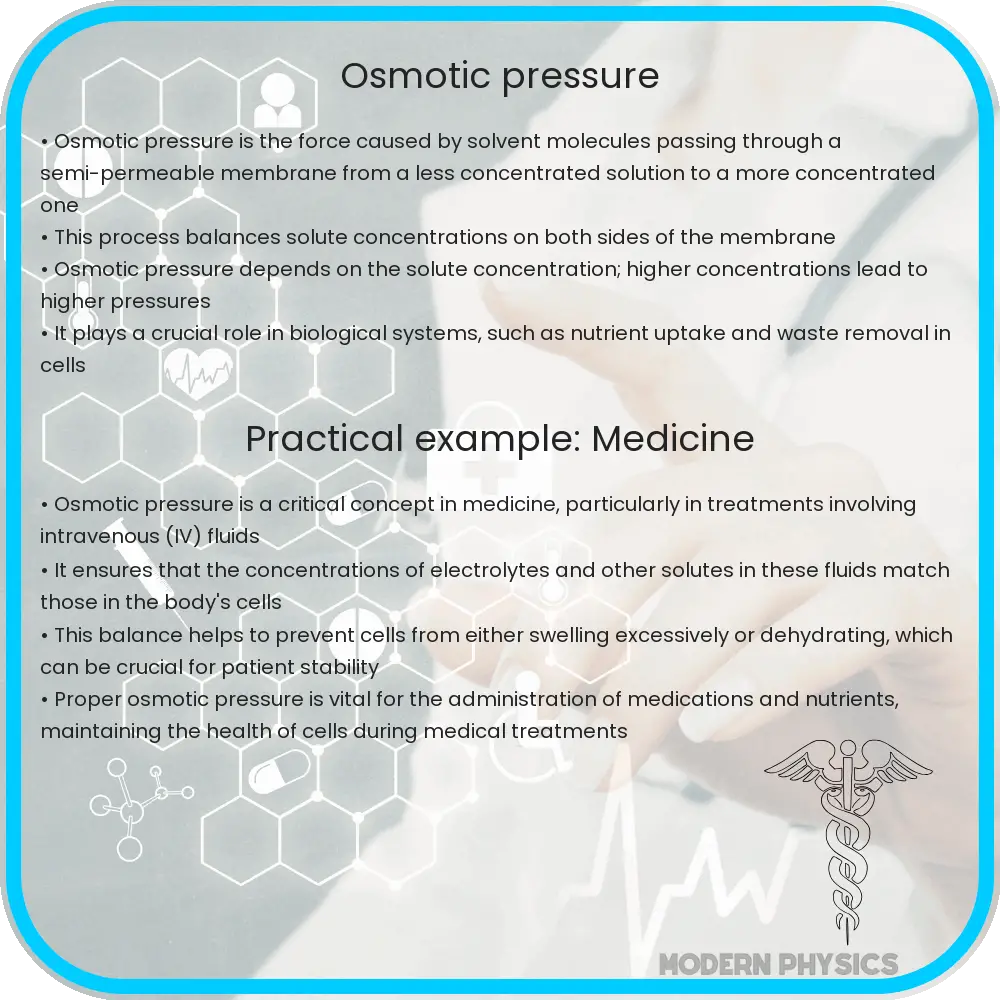Explore the essentials of osmotic pressure, its principles, applications in biology, medicine, and technology, and its role in environmental science.

Osmotic Pressure: Understanding the Basics
Osmotic pressure is a fundamental concept in chemistry and biology, crucial for understanding various physiological processes and industrial applications. This pressure is an essential aspect of osmosis, the movement of solvent molecules through a semipermeable membrane from a region of lower solute concentration to one of higher concentration.
The Principle of Osmosis
In osmosis, solvent molecules move to balance solute concentrations on both sides of a semipermeable membrane. This movement creates a pressure known as osmotic pressure. This pressure is a colligative property, meaning it depends on the solute concentration but not on its identity. It can be calculated using the formula:
P = iCRT
Pstands for osmotic pressure,iis the van ‘t Hoff factor, indicating the number of particles the solute dissociates into,Cis the molar concentration of the solution,Ris the gas constant,Tis the temperature in Kelvin.
Applications in Biological Systems
Osmotic pressure is vital in biological systems, regulating the movement of water and nutrients in and out of cells. It maintains cell turgor in plants and is integral to the kidney’s function in maintaining blood pressure and fluid balance in animals. Imbalances in osmotic pressure can lead to conditions like dehydration or edema.
Industrial and Technological Relevance
In industry, osmotic pressure finds applications in water purification, food processing, and pharmaceuticals. Reverse osmosis, a process where pressure is applied to overcome osmotic pressure, is widely used for desalination and wastewater treatment. Understanding osmotic pressure is also crucial in developing drug delivery systems and preserving food by controlling water activity.
Conclusion
Osmotic pressure plays a pivotal role in various scientific fields. Its understanding is crucial for advancements in health, environmental technology, and many other sectors. The next part of this article will delve deeper into the mathematical aspects and advanced applications of osmotic pressure.
Advanced Concepts in Osmotic Pressure
Delving deeper into osmotic pressure, it’s important to understand its quantitative aspects and advanced applications. The van ‘t Hoff equation for osmotic pressure, P = iCRT, lays the foundation for these discussions. The equation simplifies for ideal solutions but can be modified for real solutions where interactions between solute particles become significant.
Mathematical Modelling and Osmotic Coefficients
In real-world applications, the ideal model of osmotic pressure often needs adjustment. This is where the concept of osmotic coefficients comes into play. These coefficients, which vary depending on the solute and solvent, correct the van ‘t Hoff equation to more accurately reflect real solution behaviors. Incorporating these coefficients is essential for precise calculations in industrial processes and scientific research.
Role in Medicine and Physiology
In medicine, osmotic pressure is critical for understanding fluid balance and the action of drugs. For instance, intravenous solutions must be isotonic to prevent damage to blood cells. Osmotic pressure is also key in understanding the mechanism of action of diuretics and in treating conditions like hyponatremia (low sodium levels in the blood).
Environmental and Agricultural Applications
Osmotic pressure also has significant applications in environmental science and agriculture. In soil science, it helps understand water uptake by plants and soil salinity. Osmotic treatments can enhance the drought resistance of crops, an increasingly vital technique in the face of climate change.
Technological Advances: Osmotic Power Generation
A fascinating application of osmotic pressure is in renewable energy generation, specifically osmotic power. This technology harnesses the energy potential from the difference in salt concentration between freshwater and seawater, offering a promising, sustainable energy source.
Conclusion
Osmotic pressure is not just a theoretical concept but a driving force behind many biological, environmental, and technological phenomena. Its principles guide everything from maintaining cellular integrity to advancing renewable energy. The ongoing research and development in understanding and utilizing osmotic pressure promise continued innovation and improvement in various fields, making it a subject of enduring significance and interest.
